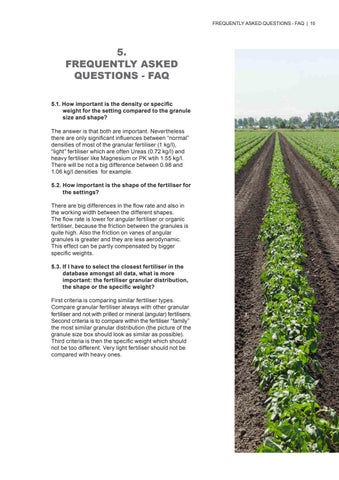FREQUENTLY ASKED QUESTIONS - FAQ | 15
5. FREQUENTLY ASKED QUESTIONS - FAQ 5.1. How important is the density or specific weight for the setting compared to the granule size and shape? The answer is that both are important. Nevertheless there are only significant influences between “normal” densities of most of the granular fertiliser (1 kg/l), “light” fertiliser which are often Ureas (0.72 kg/l) and heavy fertiliser like Magnesium or PK wtih 1.55 kg/l. There will be not a big difference between 0.98 and 1.06 kg/l densities for example. 5.2. How important is the shape of the fertiliser for the settings? There are big differences in the flow rate and also in the working width between the different shapes. The flow rate is lower for angular fertiliser or organic fertiliser, because the friction between the granules is quite high. Also the friction on vanes of angular granules is greater and they are less aerodynamic. This effect can be partly compensated by bigger specific weights. 5.3. If I have to select the closest fertiliser in the database amongst all data, what is more important: the fertiliser granular distribution, the shape or the specific weight? First criteria is comparing similar fertiliser types. Compare granular fertiliser always with other granular fertiliser and not with prilled or mineral (angular) fertilisers. Second criteria is to compare within the fertiliser “family” the most similar granular distribution (the picture of the granule size box should look as similar as possible). Third criteria is then the specific weight which should not be too different. Very light fertiliser should not be compared with heavy ones.





